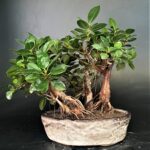Medicinal & Herbs Bonsai in India
Medicinal Bonsai & Herbs Bonsai: An Innovative Approach to Bonsai Gardening.
Bonsai of Herbs and Medicinal Plants:
Creating Your Own Miniature Garden

Are you a fan of herbs and medicinal plants but lack the space for a full-fledged garden? Worry not, as bonsai of herbs and medicinal plants can be a perfect solution. This Japanese art form of growing miniature trees in containers can also be applied to growing herbs and medicinal plants in small pots, creating a stunning and practical addition to your home.
In this article, we will explore the world of bonsai of herbs and medicinal bonsai plants and provide a step-by-step guide to creating your miniature garden. With a little patience, creativity, and attention to detail, you can have a beautiful and functional collection of bonsai herbs and medicinal plants that will not only add a touch of greenery to your home but can also be used for cooking and medicinal purposes.
Getting Started: Choosing Your Medicinal Bonsai & Herbs Bonsai Plants

The first step in creating a bonsai of herbs and medicinal plants is choosing the right specimens to work with. Some popular herbs that are suitable for bonsai include thyme, rosemary, and basil, while medicinal plants such as aloe vera, ginseng, and chamomile can also be grown as bonsai. It is essential to select plants that are healthy, disease-free, and have a compact growth habit.
Planting Your Medicinal Bonsai & Herbs Bonsai: Tips and Tricks

Once you have selected your herbs and medicinal plants, the next step is to plant them in a container suitable for bonsai. It is recommended to use shallow containers with adequate drainage holes, as this will allow the plants to thrive in a confined space. Additionally, using a well-draining soil mix that is specifically designed for bonsai will ensure that your plants receive the necessary nutrients while preventing waterlogging and root rot.
When planting your bonsai, it is crucial to pay attention to the positioning and spacing of the plants. The aim is to create a visually appealing arrangement that allows each plant to grow and thrive without being overcrowded. It is also essential to prune and shape the plants regularly, as this will help maintain their compact size and encourage healthy growth.
Caring for Your Bonsai: Watering, Feeding, and Maintenance

Proper care and maintenance are crucial to the health and longevity of your bonsai of herbs and medicinal bonsai plants. Watering your plants regularly is essential, and it is recommended to use a watering can or spray bottle to avoid overwatering. Fertilizing your bonsai with a balanced, slow-release fertilizer will provide the necessary nutrients for healthy growth.
Regular pruning and shaping are also necessary to maintain the size and shape of your bonsai. It is essential to use sharp, sterile pruning tools to avoid damaging the plants and to remove any dead or diseased branches promptly. Additionally, repotting your bonsai every two to three years will ensure that the roots have enough space to grow and receive adequate nutrients
How to Create Medicinal Bonsai of Herbs and Medicinal Plants
Creating bonsai of herbs and medicinal plants is not as complicated as it may seem. Here are the steps to get started:
Step 1: Choose the right plants
Not all herbs and medicinal plants are suitable for bonsai gardening. It is essential to choose plants that can thrive in small pots and can tolerate regular pruning.
Although Below mentioned herbs dont make a good shaped specimen, but you can boast of having your own pharmacy at home. Some of the best herbs and medicinal plants for bonsai gardening include:
- Rosemary
- Oregano
- Tulsi
- Thyme
- Basil
- Sage
- Lavender
- Chamomile
- Echinacea






Step 2: Select the right container

The container you choose for your bonsai of herbs and medicinal plants should be shallow and have good drainage. You can choose from a variety of materials, including ceramic, plastic, or terra cotta. It is essential to choose a container that complements the size and style of your plant.
Step 3: Prune and shape your plant
Pruning and shaping are the most critical aspects of bonsai gardening. Regular pruning helps maintain the miniature size of the plant and encourages new growth. Shaping involves training the plant to grow in a particular way to achieve an aesthetically pleasing appearance.
Step 4: Provide the right growing conditions

Herbs and medicinal plants require specific growing conditions to thrive. Ensure that your bonsai of herbs and medicinal plants receive adequate sunlight, water, and nutrients. Most herbs and medicinal plants prefer well-draining soil and a pH range of 6.0 to 7.0.
Tips for Maintaining Bonsai of Herbs and Medicinal Plants
Maintaining bonsai of herbs and medicinal plants is relatively easy, but it does require some effort. Here are some tips to help you keep your miniature garden healthy and thriving:

- Water your plants regularly, but avoid over-watering, which can lead to root rot.
- Fertilize your plants every two weeks during the growing season.
- Prune your plants regularly to maintain their shape and size.
- Repot your plants every two to three years to ensure they
A List of Medicinal Plant Trees along with their uses which can be grown as Bonsai in India.
Common Name | Botanical Name | Common Uses | ||
Neem | Azadirachta indica | Antibacterial, antiviral, antifungal, anti-inflammatory, and antipyretic properties. Used to treat skin disorders, fever, infections, and digestive disorders. | ||
Amla | Phyllanthus emblica | High in vitamin C, used to treat respiratory and digestive disorders, and improve skin and hair health. | ||
Ashoka | Saraca asoca | Used to treat gynecological disorders, dysentery, and inflammation. | ||
Arjuna | Terminalia arjuna | Used to treat heart disease, high blood pressure, and respiratory disorders. | ||
Bael | Aegle marmelos | Used to treat digestive disorders, fever, and respiratory infections. | ||
Haritaki | Terminalia chebula | Used to treat digestive disorders, respiratory infections, and skin disorders. | ||
Sandalwood | Santalum album | Used in Ayurvedic medicine for its antiseptic, anti-inflammatory, and sedative properties. Used to treat skin disorders, anxiety, and stress. | ||
Tulsi | Ocimum tenuiflorum | Used to treat respiratory and digestive disorders, and as a general health tonic. | ||
Peepal | Ficus religiosa | Used to treat digestive disorders, respiratory infections, and skin disorders. | ||
Jamun | Syzygium cumini | Used to treat diabetes, skin disorders, and digestive disorders. | ||
Guggul | Commiphora wightii | Used to treat arthritis, high cholesterol, and obesity. | ||
Parijat | Nyctanthes arbor-tristis | Used to treat fever, digestive disorders, and skin disorders. | ||
Bakul | Mimusops elengi | Used to treat skin disorders, dental problems, and as a mild sedative. | ||
Chandan | Santalum album | Used to treat skin disorders, anxiety, and stress. | ||
Bilva | Aegle marmelos | Stomach Problems | ||
Kachnar | Bauhinia variegata | Used to treat respiratory disorders, digestive disorders, and fever. | ||
Kadamba | Anthocephalus cadamba | Used to treat skin disorders, fever, and digestive disorders. | ||
Banyan | Ficus benghalensis | Used to treat diabetes, dysentery, and diarrhea. The leaves are used to treat fever and the roots are used to treat asthma. | ||
Sandalwood | Santalum album | Used to treat skin infections, anxiety, and insomnia. It is also used as an anti-inflammatory and to lower blood pressure. | ||
Indian Elm | Holoptelea integrifolia | Used to treat liver disorders, snakebites, and skin diseases. The bark is used as an antiseptic and to treat wounds. | ||
Teak | Tectona grandis | Used to treat skin diseases, digestive disorders, and respiratory problems. It is also used to treat fever and as an anti-inflammatory. | ||
Mango | Mangifera indica | Used to treat anemia, diarrhea, and dysentery. The leaves are used to treat diabetes and hypertension. | ||
Indian Gooseberry | Phyllanthus emblica | Used to treat diabetes, digestive disorders, and respiratory problems. It is also used to improve eyesight and boost immunity. | ||
Indian Kino Tree | Pterocarpus marsupium | Used to treat diabetes, wounds, and skin infections. It is also used as an anti-inflammatory and to reduce fever. | ||
Jamun | Syzygium cumini | Used to treat diabetes, diarrhea, and dysentery. The bark and seeds are also used to treat dental problems. | ||
Indian Rosewood | Dalbergia sissoo | Used to treat skin diseases, respiratory problems, and fever. It is also used to improve digestion and as an anti-inflammatory. | ||
White Willow | Salix alba | Used to treat pain, fever, and inflammation. It is also used to treat rheumatism, menstrual cramps, and headache. | ||
Note: This is not an exhaustive list of all the medicinal trees in India and the information provided is not intended to replace medical advice. It is always recommended to consult a healthcare professional before using any herbal remedies. {website is not responsible for correctness of common name vis a vis botanical name, please co-relate with scientific journals} [ref: wikipedia, Science journal, Indian Medicine system, Medicinal Plants of India, Ancient medicine system Vol 3] | ||||
Still, there are many questions unanswered as given below:-

Further reading













Our Motto
What you see is what you get
Delivery
Personalised delivery at door step
Mission
Creating green spaces



